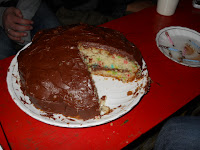I can tell that school in Sikkim has finally started. I felt such a sense of accomplishment after a day as Acting Principal during which many things happend. During the day yesterday:
- The geysers (hot water heaters) were fixed in the rooms where the student boarders live, and the water filters were changed in the water filtration system. To get this done, it required a call to a board member last week who called in a special favor with someone he knows who fixes geysers. Then the principal's assistant had to arrange for the man to get a ride to school (no one wants to travel all the way to the jungle to fix our equipment!). By the way, there is no running hot water in Sikkim. Every bathroom and shower has it's own small hot water heater. So I just found out today that besides the ones that needed to be fixed, we now need to purchase 6 more for the new Boys' Hostel. That means 6 more pieces of equipment that will need to be fixed within a month or two!
- The water tank that provides water for the kitchen staff and the cooks was cleaned. Many students in the hostel got gastroenteritis before anyone paid attention to the water tank. Even I had noticed that there was often sand in the rice. Come to find out, the tank was so dirty there were worms living in it.
- The Head of Administration came to see that she is not taking, and does not want to take, the responsibility for being the person in charge of the administrative side of the school. She has been expected to oversee so much, but really doesn't want to take on that level of responsibility now that the school has grown so large. The problem is, where is the school going to find someone capable of taking on that kind job?
- I informed the principal's assistant that she was getting a lower raise than she wanted. She cried over it and then shared with me that she had expected to get a 50% raise this year because she had been offered a government job at the higher salary and turned down that job last year (unbeknownst to anyone at Taktse). She has never told her family how much money she makes because she feels bad about the amount she makes, and her family expects her to send money home regularly. Her mother really wanted her to take the government job and she refused to because she felt she would learn more working at Taktse. Still, she was counting on the fact that her salary would be raised to the government job level so that she wouldn't have to feel bad anymore about her salary.
- I received a suggestion from a board member to buy pressed-leaf plates to use during snack rather than using old student papers. Right now snack is handed out on old worksheets that students completed in their classrooms. It never dawned on me until yesterday -- who spends all that time collecting and cutting old worksheets for our snack?
- Five students were sent to the hospital for various illnesses -- a broken foot, back pain, vomiting. They rode down in the school car but came back to school in a taxi.


















































